
Isopoda is an order of crustaceans. Members of this group are called isopods and include both aquatic species, and terrestrial species such as woodlice. All have rigid, segmented exoskeletons, two pairs of antennae, seven pairs of jointed limbs on the thorax, and five pairs of branching appendages on the abdomen that are used in respiration. Females brood their young in a pouch under their thorax.

Aglajidae is a family of often colorful, medium-sized, sea slugs, marine opisthobranch gastropod mollusks. These are not nudibranchs; instead they are headshield slugs, in the clade Cephalaspidea.

Elysia timida is a species of sacoglossan sea slug, a marine opisthobranch gastropod mollusk. Found in the Mediterranean and nearby parts of the Atlantic, it is herbivorous, feeding on various algae in shallow water.
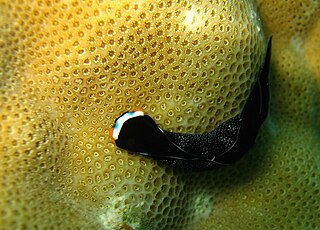
Mariaglaja inornata, also called the inornate headshield slug, is a species of sea slug or headshield slug, a marine opisthobranch gastropod mollusc in the family Aglajidae.
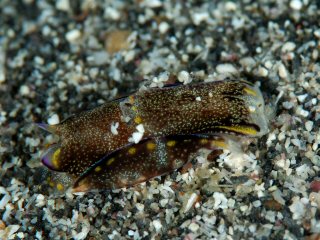
Philiopsis is a genus of often colorful, medium-sized sea slugs, marine opisthobranch gastropod mollusks. These are not nudibranchs; instead they are headshield slugs, in the clade Cephalaspidea.

Melanochlamys is a genus of headshield slugs in the family Aglajidae. Despite the appearance of its species, this genus must not be confused with nudibranchs.

Pearsonothuria is a genus of sea cucumbers in the family Holothuriidae. Pearsonothuria graeffei is the only species in the genus. Graeffe's sea cucumber is found in the tropical Indo-Pacific Ocean and the type locality is Viti Island, Fiji. It is named after Eduard Heinrich Graeffe, Semper's coworker at the Museum Godeffroy.
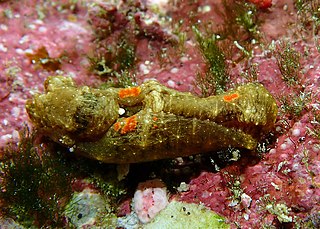
Aglaja is a genus of sea slugs, marine opisthobranch gastropod mollusks in the family Aglajidae. The genus is found in all warm and temperate oceans.

Siphopteron quadrispinosum is a species of small sea slug, a marine opisthobranch gastropod mollusc in the order Cephalaspidea, the headshield slugs. This slug is a simultaneous hermaphrodite.

Scyllaea pelagica, common name the sargassum nudibranch, is a species of nudibranch, a marine gastropod mollusc in the family Scyllaeidae. This species lives among floating seaweed in the world's oceans, feeding on hydroids.
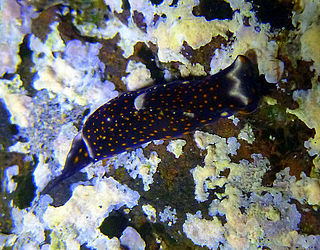
Biuve fulvipunctata, the white-speckled headshield slug, is a species of sea slug or headshield slug, a marine opisthobranch gastropod mollusc in the family Aglajidae. This species is widespread in the Indian and Pacific Oceans but has invaded the Mediterranean Sea since 1961, despite apparently being absent from the Red Sea until recorded there in the 21st century. It is the only species in the monotypic genus Biuve.

Syllis prolifera is a species of polychaete worm in the family Syllidae. It has a cosmopolitan distribution. It was first described in 1852 by the Russian/German zoologist August David Krohn who gave it the name Syllis prolifera.
Berthella ocellata is a species of sea slug, a marine gastropod mollusc in the family Pleurobranchidae. It is native to the eastern Atlantic Ocean and the Mediterranean Sea where it inhabits the shallow sublittoral zone.

Melanochlamys cylindrica is a species of bubble snail in the family Aglajidae. It is endemic to New Zealand.
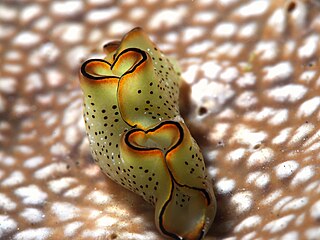
Elysia marginata is a marine gastropod in the family Plakobranchidae. It is known for its ability to regenerate its whole body and heart after autotomizing it from its head.

Philinopsis speciosa, the blue-lined philinopsis, is a species of sea slug, a shell-less opisthobranch gastropod mollusc in the family Aglajidae.

Tubulophilinopsis gardineri, the Gardiner’s philinopsis, or Gardiner's headshield slug is a species of sea slug, a shell-less opisthobranch gastropod mollusc in the family Aglajidae. It is native to the Indo-Pacific region.

Thuridilla vataae is a species of sacoglossan sea slug, a shell-less marine opisthobranch gastropod mollusc in the family Plakobranchidae. It is native to the tropical Indo-Pacific. It was first described by the French zoologist Jean Risbec in 1928; its specific name refers to the Bay of Anse Vata, just south of Nouméa, New Caledonia, where the type specimen was collected.

Thuridilla moebii is a species of sacoglossan sea slug, a shell-less marine opisthobranch gastropod mollusc in the family Plakobranchidae. It is found in shallow water in the tropical west and central Indo-Pacific region.
Aglaja tricolorata is a species of sea slug, an opisthobranch gastropod mollusc in the family Aglajidae. It is native to the Mediterranean Sea and the tropical eastern Atlantic Ocean where it lives in shallow water on the sandy seabed.
















